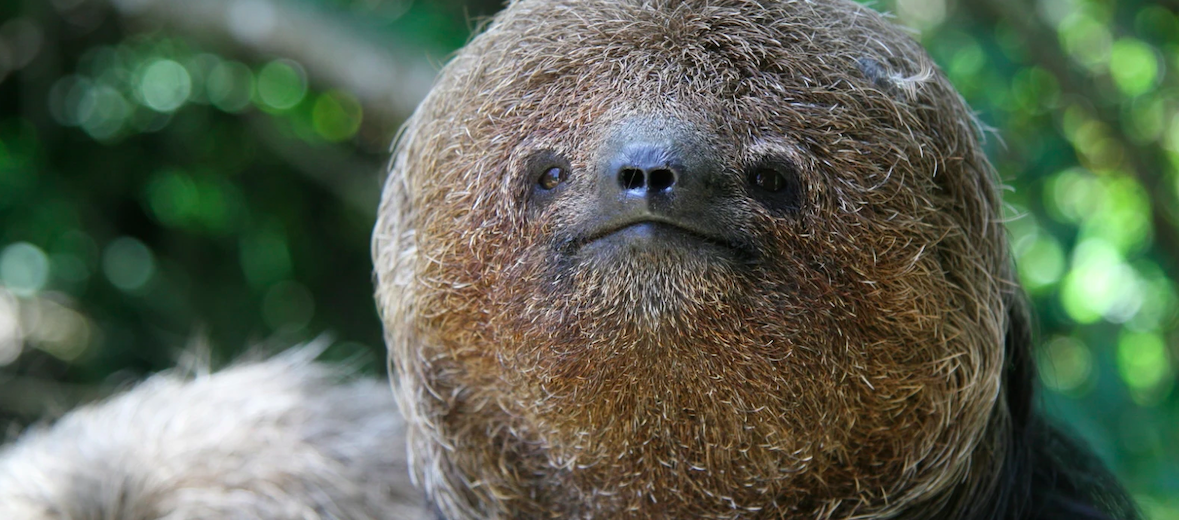
The maned three-toed sloth is the largest known member of the three-toed sloth family and hails only from the Atlantic coastal rainforests of Brazil. These sloths get their name from the mane of black hair that runs from their neck and over their shoulders. They prefer evergreen forests, semi-deciduous forests, and secondary forests that are hot and typically have no dry season. With the threats of habitat destruction at the hands of agriculture, and the logging industry, vehicle strike (being hit by vehicles), hunting, and trapping, these creatures are listed as Vulnerable by the IUCN. Their numbers are also decreasing.
First the Stats…
Scientific name: Bradypus torquatus
Weight: Up to 22 lbs.
Length: Up to 2.5 feet
Lifespan: Up to 12 years
Now on to the Facts!
1.) These sloths are diurnal (active during the day).
2.) Even though they are diurnal, they spend the night and most of the day asleep. This is due to the low quality of nutrition they get from their diet.
3.) The maned sloth, like all sloths, has very low muscle mass, in comparison to other mammals their size.
4.) Venturing to the ground is dangerous, so they only do so once a week to defecate (poop and pee) and to switch trees (when they can’t just reach the branches of a neighboring tree).
5.) When faced with a predator, they either lay motionless or can slash with their sharp claws.
But wait, there’s more on the maned three-toed sloth!
6.) They feast exclusively on tree and liana leaves. These critters have a preference for younger tree leaves as they are softer and easier to digest. Liana leaves are tougher to process, but are still resorted to, at times.
7.) The majority of their breeding occurs from February – April. But they are able to breed year round.
Did you know…?
Their ground speed clocks in at only around .15 mph.
8.) Maned sloths are so adept at climbing trees that they eat, sleep, and even breed while hanging from tree branches. Thus making them strictly arboreal (spend their lives in trees). Sloths have even been found hanging from tree branches after death.
9.) Females undergo up to a 6 month gestation (pregnancy) that yields a single baby.
10.) Babies weigh in at 11 ounces and begin taking solid food at around 2 weeks. They are weened by 2 – 4 months.
But wait, there’s still more on the maned three-toed sloth!
11.) The primary predators or maned sloths are jaguars, ocelots, and harpy eagles. All of which are sight hunters that rely on movement to detect their prey. So the slow movements of these sloths help keep them relatively safe.
Did you know…?
The sloth’s fur is used by insects as a mobile micro-ecozone. Insects like biting and blood-sucking flies and mosquitoes, sandflies, triatomine bugs, lice, ticks, mites, moths, and cockroaches can all be found among the sloth’s fur.
12.) As is the case with all sloths, their fur grows backwards, from their stomach to their back. Not the other way around, like other mammals. This aids in directing rain water down and away from the sloth.
13.) Their name comes from how many actual toes they have on their hind limbs.
14.) Like all sloths, the maned three-toed sloth is an excellent swimmer and actually moves faster while in the water.
15.) They move so slowly that green algae grows on their fur.
Now a Short Maned Three-Toed Sloth Video!
Be sure to share & comment below! Also, check out the Critter Science YouTube channel. Videos added frequently!
Want to suggest a critter for me to write about? Let me know here.



